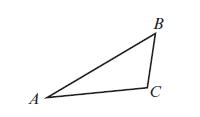Solving geometric problems
The points \(A\) and \(B\) have position vectors \(4i+2j+7k\) and \(3i+4j-k\) relative to a fixed origin \(O\). Find \(A \to B\) and show that \(\delta OAB\) is isosceles.
- \(A \to B=-i+2j-8k\)
- \(\sqrt{ 4^2+2^2+7^2 }=\sqrt{ 69 }\)
\(\sqrt{ 1^2+2^2+8^2 }=\sqrt{ 69 }\)
\(\sqrt{ 3^2+4^2+1^2 }=\sqrt{ 26 }\)
\(|OA|=|AB|\)
Therefore triangle is isosceles
Find the angle that the vector \(\mathbf{a}=2\mathbf{i}+\mathbf{j}+\mathbf{k}\) makes with the x axis.
- \(\arccos\left( \frac{2}{\sqrt{ 6 }} \right)=35.3^{\circ}\)
Find the angle that \(\mathbf{b}=\mathbf{i}+3\mathbf{j}+2\mathbf{k}\) makes with the x-axis.
- \(\arccos\left( \frac{1}{\sqrt{ 14 }} \right)=74.5^{\circ}\)
Explain why the difference between these angles does not give you the angle between \(\mathbf{a}\) and \(\mathbf{b}\)
- May not be coplanar (lie on the same plane)
Given that \((3a+b)\mathbf{i}+\mathbf{j}+ac\mathbf{k}=7\mathbf{i}-b\mathbf{j}+4\mathbf{k}\) find the values of \(a\), \(b\) and \(c\)
- \(3a+b=7\)
- \(ac=4\)
- \(b=-1\)
- \(3a=8\)
- \(a=\frac{8}{3}\)
- \(\frac{8}{3}\times c=4\)
- \(c=\frac{3}{2}\)
The diagram shows a triangle \(ABC\). Given that \(A \to B=7\mathbf{i}-\mathbf{j}+2\mathbf{k}\) and \(B \to C=-\mathbf{i}+5\mathbf{k}\), find the area of the triangle \(ABC\).
